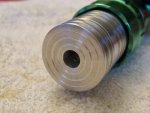I'm considering getting another laser pointer mainly to use for astronomy, bird watching, general pointing.
Looking for:
1) Does the job of pointing/visibility very well. Not into burning.
2) If it does the job, then safety from anything accidental.
For reference:
I purchased 2 laser pointers from ebay (advertised as 35mw and 100mw) of the 302 type, 532nm
I don't notice a difference between the advertised 35mw/100mw. So maybe wattage doesn't make a difference for visual/pointing observation.
I would like to purchase something safer, and also use as a screen pointer.
Is there anything better?
What about these options:
1) Z-Bolt BTG-6-P (Premium). I like the solid look, but maybe it's not as solid as it looks.
2) Wicked Laser Nano (5mw or 15mw). I like the lockout feature, not sure if 15mw is that much better than 5w.
What about 515nm? Or 520nm? versus 532nm?
What about OSRAM vs. APC vs. cheap ebay?
What about beam width?
Or are they all really the same, unless you want to burn?
Thanks
Looking for:
1) Does the job of pointing/visibility very well. Not into burning.
2) If it does the job, then safety from anything accidental.
For reference:
I purchased 2 laser pointers from ebay (advertised as 35mw and 100mw) of the 302 type, 532nm
I don't notice a difference between the advertised 35mw/100mw. So maybe wattage doesn't make a difference for visual/pointing observation.
I would like to purchase something safer, and also use as a screen pointer.
Is there anything better?
What about these options:
1) Z-Bolt BTG-6-P (Premium). I like the solid look, but maybe it's not as solid as it looks.
2) Wicked Laser Nano (5mw or 15mw). I like the lockout feature, not sure if 15mw is that much better than 5w.
What about 515nm? Or 520nm? versus 532nm?
What about OSRAM vs. APC vs. cheap ebay?
What about beam width?
Or are they all really the same, unless you want to burn?
Thanks







